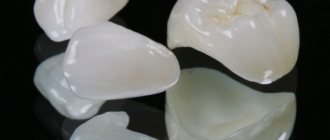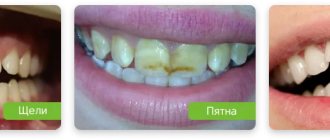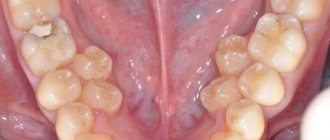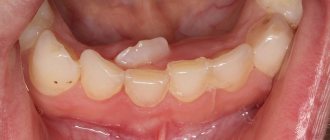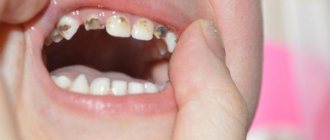- home
- Services
- Dental restoration for children
Baby teeth appear in a child from 6-9 months and are replaced by permanent teeth until the age of 12-14 years. Children's teeth, especially at an early age, are very vulnerable and susceptible to decay. It is careful attention to baby teeth that is the key to timely and correct growth of permanent dentition. A child with straight and beautiful teeth develops chewing and facial muscles correctly. Premature loss of even one baby tooth, untreated caries, crown injuries lead to the following problems:
- increased load on neighboring teeth;
- violation of growth order;
- deformations of the entire dentition;
- the occurrence of diction defects;
- deterioration of chewing function;
- aesthetic defects.
Changing the position of the rudiments of permanent teeth is a high risk of serious malocclusion, which is fraught with serious orthodontic treatment in the future. Natadent clinic specialists fight for every child’s tooth.
What is dental restoration
Restoration of baby teeth in children is carried out in the following cases:
- for damage caused by trauma;
- due to complicated caries.
Dental injuries in childhood are common. At the children's dental clinic "Natadent" we are ready to provide timely and qualified assistance. According to statistics, every third child suffers a tooth injury during sports games or vigorous activity.
By acting correctly, you can even save a knocked out tooth:
- Regardless of the severity of the injury, you should come for an examination to a pediatric dentist;
- take a photo to assess the nature of the damage;
- if displaced, the tooth must be strengthened by applying a splint or in another way at the discretion of the doctor;
- Deliver the child, along with the knocked out tooth, to the dentist’s office within 30 minutes.
Important! A knocked-out tooth cannot be picked up by the root, washed with water or treated with antiseptic solutions - this can make the process of its healing impossible and complicate restoration. It must be carefully taken by the crown and placed in saline solution, on the child’s cheek or in another biological environment.
If a piece of enamel breaks off from an injured tooth and dentin is exposed, then it cannot be left in this form. It is necessary to see a dentist and restore the damaged edge. Through a thin layer of dentin, pathogenic bacteria will enter the pulp and cause pulpitis. This can lead to tooth decay and costly treatment.
The Natadent clinic has all the possibilities for preserving teeth, restoring them and restoring them. We are sure that tooth injury is not a reason for losing it.
Sealing
Filling is the only method of artistic restoration of teeth that does not have any age restrictions. In this case, not only primary, but also dairy units should be subject to restoration. It is very important to restore all fissures, tubercles and irregularities on the teeth lost due to caries or injuries, because they are necessary for thoroughly chewing food.
Baby teeth can be restored using colored filling materials, which is very popular with young children. However, such fillings can only be installed on the surface of chewing teeth; they are not used in the smile area.
Of course, it can be very difficult for a small child to sit still for 30-60 minutes while the dentist is working. No more than one tooth can be restored at a time. In addition, most children are very afraid to visit doctors, so restoration has to be postponed for several years.
Recovery methods
Several methods can be used to restore a child's teeth. The type of restoration is chosen by the dentist depending on the nature and degree of destruction.
The difficulty of a dentist’s work during the process of tooth restoration is that children quickly get tired due to the need to remain static in a chair. Therefore, the Natadent Children's Dental Clinic provides the possibility of dental treatment under local anesthesia, general anesthesia or inhalation sedation.
Sealing
If a tooth is partially damaged, the dentist evaluates the condition of the remaining hard tissues and the quality of the soft tissues around the crown and roots. The following filling options are possible:
- treatment of the canals of a baby tooth and placing a filling at the gum level so that the tooth is not in the bite and does not experience stress;
- restoration using filling material.
Light-curing composite materials have many advantages:
- the dentist can completely build up a child’s tooth and recreate the crown relief;
- the chewing surface becomes durable;
- there is no release of harmful substances into the child’s body;
- the material hardens under UV light;
- You can achieve a high cosmetic effect and the required degree of transparency of the filling.
To prevent the formation of cracks during the life of the child and during shrinkage, the dentist forms a filling when building up layer by layer. The composite has the ability to hermetically close any microcracks and firmly connect to dentin.
Light-composite materials are a real innovation in dentistry, with the help of which filling and restoration of teeth has become less traumatic and most effective.
Crown installation
Carrying out this procedure in children is surprising, but not among the specialists at the Natadent clinic.
It is recommended to use the following method:
- for large chips;
- with significant tooth destruction of 50% or more.
If the chewing surface and one of the side walls of the tooth are lost, the remaining thin walls will not withstand the chewing load for a long time.
Installing a crown is a reliable way to save a baby tooth from destruction and maintain its functionality until it is replaced with a permanent one.
Crowns help:
- chew food thoroughly, which is important for the vulnerable gastrointestinal tract system;
- prevent the appearance of persistent speech defects, which is especially important during the period of active development of the child and preparation for school;
- form the correct bite.
Timely protection of teeth with crowns is an opportunity to minimize further destruction of baby teeth, the development of secondary caries and prevent improper development of permanent teeth.
Natadent pediatric dentistry uses two types of crowns:
- ceramic for the front teeth, which do not differ from natural incisors in color and shape and do not violate the aesthetics of the smile;
- metal, made of stainless steel, which are the ideal solution for restoring the function of chewing teeth.
Modern crowns are high-quality products with a unique design; they do not require significant grinding of the tooth, but significantly prolong its life. At the clinics of the Natadent network, we restore teeth for children in the same aesthetic and beautiful way as for adults.
What problems does artistic restoration solve?
The main goal of restoration is to restore the aesthetic appeal of the smile. Due to caries, the enamel and dentin of the tooth are damaged, which requires a filling procedure with special materials. Also, restoration may be required for previously poorly installed fillings that are irregular in shape and prevent normal jaw closure.
Restoration can also help in case of non-carious lesions of the child’s teeth, for example, fluorosis, aplasia, hypoplasia, etc. These pathologies can lead not only to external changes, but also to the appearance of functional disorders. These diseases cause rapid destruction of once healthy units, so you should consult a doctor as quickly as possible.
Also, artistic restoration is an excellent solution for discoloration (different colors of individual teeth due to a previous disease or serious injury to the jaw), when there is a strong difference in the size and shape of teeth, when there are large gaps in a row, and in many other cases. There are many methods for eliminating these deviations from the norm; the choice of a specific one depends on the clinical picture of the patient.
Reviews
Your feedback is to help potential patients make the right choice. Leave your suggestions or comments so we can work even better.
LEAVE FEEDBACK
Prosthetics and veneers
Young age is not an absolute contraindication for dental prosthetics. In practice, there are cases of successful installation of crowns and dentures in children under the age of one year. Unfortunately, this is often the only method that can help prevent tooth decay due to caries and other pathologies. You can install a crown on a tooth almost immediately after the unit has erupted.
Another restoration method is the production of microprostheses. This concept refers to the use of thin overlays on teeth, called veneers or lumineers. Microprostheses can be made of various materials: ceramics, porcelain, metal, composite, etc. Such onlays are highly durable compared to conventional fillings; they allow you to restore a tooth even if there is a large damaged area. It makes no sense to install such onlays on baby teeth; cheaper and simpler methods are suitable for this purpose.
There are strict age restrictions when installing veneers and lumineers. They are suitable for patients over 18 years of age, but in rare cases they can be used after 12 years of age. In any case, the final decision on the advisability of carrying out restoration and using a particular method is made by the attending physician.
previous post
Causes of damage to baby teeth
next entry
Why is it necessary to treat baby teeth?
Damaged baby teeth definitely require treatment!
Not everyone knows that caries in a baby tooth develops more rapidly than in a permanent tooth. The entire destruction process takes place in several stages:
- First, demineralization of the enamel begins (this occurs due to regular consumption of foods rich in sucrose and carbohydrates);
- Gradually, the enamel is destroyed superficially (the white spot stage of the carious process). At this stage, with timely treatment, caries can be completely cured.
- Directly caries - in this case, dentin begins to collapse. If the need for treatment is ignored at this stage, the pulp, the nervous system of the tooth, is damaged.
- Periodontitis and pulpitis, accompanied by pain. If they are not treated, a chronic process occurs.
Remember that diseased teeth are a source of constant infection, and it does not remain in the oral cavity, but spreads to the nasopharynx, and then throughout the body. There can be serious consequences to early tooth loss, so never ignore tooth decay.
When should you take your child to the dentist?
When does it become necessary to restore baby teeth? A visit to the dentist with a child is necessary if:
- the destruction of enamel by caries has occurred so much that it cannot be restored with fillings;
- in the presence of various injuries (cracks, chips, fractures);
- an inflammatory process of the periosteum has occurred, in this case the tooth must be removed immediately;
- enamel destruction due to fluorosis occurred;
- Due to aesthetic defects in the front teeth, the baby develops complexes and discomfort.
How do you know when it's time to see a doctor?
Tooth enamel hypoplasia is a disease that is difficult to miss. The child has the following symptoms:
- Deterioration of the enamel. The top layer of teeth becomes thinner and cracks appear on it;
- A carious layer appears on the teeth;
- The baby suffers from tooth sensitivity: he reacts to cold, hot, sweet.
Despite the fact that tooth enamel is the strongest tissue in the body, it cannot regenerate on its own. If symptoms of thinning are detected, parents should consult a doctor with their baby as soon as possible.
The need for restoration
The replacement of baby teeth begins at the age of five. They serve children up to a maximum of fourteen years of age, then they fall out and are replaced by permanent ones. They are not designed to be used for a long time. This variety has some features due to which they collapse faster than permanent ones.
These include:
- the layer of enamel in dairy milk is thinner than in permanent;
- the pulp chamber is closer to the surface;
- The dentin layer is also thinner.
Due to these features, caries develops faster in children. If it is not treated, pulpitis begins at lightning speed, and the coronal part is significantly destroyed. This process can take place without pain; the child gets to the doctor late. Most often he deletes this unit. Modern dentistry now makes it possible to restore almost completely destroyed crowns. Neither parents nor dentists consider it necessary to restore, let alone prosthetize, baby teeth for two reasons. The procedure is quite expensive, and there is no great need for it, since it is believed that the permanent ones will soon grow.
However, this must be done for the following reasons:
- if several units are missing, the child’s bite will not form correctly;
- improper redistribution of the load when chewing, they can shift and cover the eruption sites;
- in the absence of incisors, the child develops complexes because he is teased by his peers;
- the sharp edge of the destroyed unit injures the mucous membranes of the child’s oral cavity;
- in the absence, chewing of food is impaired, this threatens the development of gastritis and other digestive disorders;
- The baby may develop sound pronunciation defects.
It is imperative to treat caries in a child, as it can become permanent and contribute to the development of gum disease. However, the most dangerous consequence of losing baby teeth is the formation of a malocclusion.
Features of restoration in children
Since milk teeth have significant differences from permanent teeth, there are some peculiarities.
Peculiarities of recovery in children include:
- recovery in preschoolers is temporary, it is necessary for two or three years;
- special requirements are imposed on materials (high hypoallergenicity and safety);
- structures should not interfere with jaw growth and teething;
- Before restoration, the baby tooth must be depulped.
If you take these features into account, restoration of the milk teeth will allow you to achieve the appearance of smooth and healthy permanent teeth and the formation of a correct bite.
